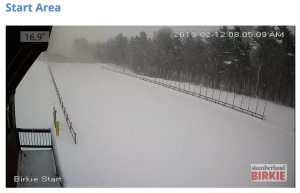
Live from the Birkie Start webcam. This is what we like to see!
The snow continues to pile up in Hayward. Nearby reporting sites in Spooner and Clam Lake have seen accumulating snow 7 of the 12 days so far this month with 15 to 21 inches of reported not including more snow today; already more snow than fell in the entire month of January (and, it’s possible, more snow in the first two weeks of February than the rest of the winter up until the start of the month). The Birkie Trail has seen a similar surfeit of snow, and should clear two feet in February by the time the storm today comes to a close.
This has been a godsend. A week ago, we would have been happy with six inches, since the base, while present, was thin. Twelve would have been terrific. Two feet? That makes the race. And the timing is perfect. With cold weather predicted between now and the race, the snow won’t go anywhere, but it will have plenty of time to be packed, groomed, and set up.
The weather between now and race day looks to be cold, but dry. There may be some light snow to freshen up the snowcover, but none of the models is pointing towards the active storm track continuing. Anything is possible, from a blizzard to a rain event, but the most likely scenario for the next 11 days (and, yes, the Birkie is just 11 days away!) is for cold, dry weather to rule. With the snow on the ground and cold in place, I see no real chance the race is anything but a full-course race from the start in Cable to Main Street in Hayward. I’ll never say never, but the chance of a full Birkie today is 99+%.
See you in Cable.

